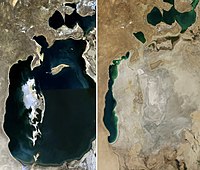
Photo from wikipedia
Understanding how ecosystem services (ES) and ecosystem disservices (EDS) are affected by human-induced landscape changes is important to minimise trade-offs and maximise synergies between Sustainable Development Goals (SDGs) and targets,… Click to show full abstract
Understanding how ecosystem services (ES) and ecosystem disservices (EDS) are affected by human-induced landscape changes is important to minimise trade-offs and maximise synergies between Sustainable Development Goals (SDGs) and targets, and for equitable development across governance scales. However, limited research investigates how ES and EDS can change under past, current, and future land uses. This study, conducted in the Luanhe River Basin (LRB), demonstrates the interaction between humans and the environment under past, current, and future land uses at the river basin scale in China, using a stakeholders’ participatory capacity matrix to characterise both ES and EDS. Results indicate that forests and water bodies provided the highest overall ES capacity, while the lowest scores were reached in built-up and unused land areas. Built-up land and cropland provided the highest overall EDS, while the lowest EDS scores were for water bodies. By applying the ecosystem services potential index (ESPI) and ecosystem disservices potential index (EDSPI), we found that the ESPI of all the ES declined from 1980 to 2018 and would continue to decline until 2030 without sustainable and conservation development strategies in the LRB. The EDSPI under all future scenarios in 2030 was projected to increase compared to the baseline in 1980. This study recommends establishing and implementing sustainable environmental protection policies and cross-regional and trans-provincial eco-compensation schemes for minimising trade-offs in ES. The study proposes an integrated research framework that could be useful for understanding the effect of historical and future human–environment interactions on ES and EDS, and SDGs achievement.
Journal Title: Sustainability Science
Year Published: 2022
Link to full text (if available)
Share on Social Media: Sign Up to like & get
recommendations!